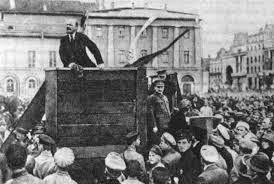In 1917, two revolutions swept through Russia, ending centuries of imperial rule and setting in motion political and social changes that would lead to the formation of the Soviet Union. In March, growing civil unrest, coupled with chronic food shortages, erupted into open revolt, forcing the abdication of Nicholas II (1868-1918), the last Russian czar. Just months later, the newly installed provisional government was itself overthrown by the more radical Bolsheviks, led by Vladimir Lenin (1870-1924).
By 1917, most Russians had lost faith in the leadership ability of Czar Nicholas II. Government corruption was rampant, the Russian economy remained backward, and Nicholas repeatedly dissolved the Duma, the Russian parliament established after the 1905 revolution, when it opposed his will. However, the immediate cause of the February Revolution–the first phase of the Russian Revolution of 1917–was Russia’s disastrous involvement in World War I (1914-18). Militarily, imperial Russia was no match for industrialized Germany, and Russian casualties were greater than those sustained by any nation in any previous war. Meanwhile, the economy was hopelessly disrupted by the costly war effort, and moderates joined Russian radical elements in calling for the overthrow of the czar.
(This information is provided the page of History.com)
Timeline- Russia Revolution
| Date | Event |
|---|---|
| 1894 | Czar Nicholas is crowned After his father, Czar Alexander III, died, Nicholas II became Czar over all of Russia. |
| 1895 | Vladmir Lenin is exiled Lenin's brother had been killed a few years before for trying to kill Czar Nicholas' father. Lenin wanted to take over power from Nicholas, and he was arrested and exiled from Russia. |
| 1903 | The Russian Social-Democrat Labor Party meets At the meeting the people were split into two groups. Some supported Lenin, and others supported a different leader. |
| 1905 | A revolution breaks out A revolution broke out in St. Petersburg, but Czar Nicholas quickly put an end to it. The day was called Bloody Sunday. |
| 1908 | Rasputin is introduced into the aristocracy Rasputin called himself a holy man and a healer, and he helped heal Czar Nicholas' sick son. Still, Rasputin wasn't a good man, and many in Russia hated him, putting the people at odds with the Czar. |
| 1914 | WWI begins World War I began and the following year, Czar Nicholas took command of the Russian Army. |
| 1916 | Rasputin is killed The plan to kill Rasputin seemed simple, but it took a lot of work to finally kill him. |
| February 1917 | Another revolution begins The people were unhappy with Czar Nicholas' rule of the country. They began protests and strikes, refusing to do their work. |
| March 1917 | Czar Nicholas tries to step down Nicholas tried to give up his throne and let his brother take over, but his brother refused. Other Russian aristocrats tried to make a temporary government. |
| July 1917 | Vladmir Lenin tries to take over Lenin came out of exile and tried to take over the temporary government, but he was chased back into hiding. |
| October 1917 | Lenin succeeds in taking over Lenin still led the split political party of the Russian Social-Democrat Labor Party, and his party soon moved in and took control of Russia. |
| 1918 | Russia backs out of WWI Lenin signed a treaty, taking Russia out of WWI. Later that year he had Czar Nicholas and his family killed. |
| March 1918 | The Communist Party is developed Lenin changed the name of his political party to the Communist Party. |
| 1922 | The USSR is established Lenin helped establish the United Soviet Socialists Republic, a communist country. He worked with Joseph Stalin. |
| 1924 | Vladmir Lenin dies After Lenin died, Joseph Stalin took over his rule. He would rule for many years to come. The Russian revolution changed Russia and all of history, introducing communism into the modern world. However, communism didn't catch on as Lenin and Stalin had hoped. Instead, demo |
Russian- Civil War
The Russian Civil War (November 1917 –
October 1922) was a multi-party war in the former Russian Empire fought between
the Bolshevik Red Army and the White Army, the loosely allied anti-Bolshevik
forces. Many foreign armies warred against the Red Army, notably the Allied
Forcesand the pro-German armies.[4] The Red Army defeated the White Armed
Forces of South Russia in Ukraine and the army led by Aleksandr Kolchak in
Siberia in 1919. The remains of the White forces commanded by Pyotr
Nikolayevich Wrangel were beaten in the Crimea and were evacuated in the autumn
of 1920.
The Treaty of Brest-Litovsk had shown to
many how weak the Bolsheviks actually were. Lenin had called for peace at any
price and the Germans had exacted very severe terms – something that was held
against them at Versailles in 1919.
At the end of 1917, the Bolsheviks only
effectively controlled Petrograd, Moscow and the territory between both cities.
With the fall of Nicholas II, many parts of the Russian empire took the
opportunity to declare their independence. Finland did so in March 1918 – and
collapsed into a civil war itself. The Whites, led by Mannerheim, were helped by
the Germans – Luderndorff even contemplated putting a German prince in power in
Finland once the Whites had won. With German help, the Finnish Whites pushed
back the Finnish-Russo border and Petrograd was almost within artillery range.




No comments:
Post a Comment